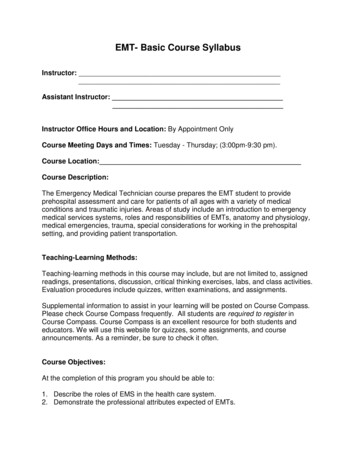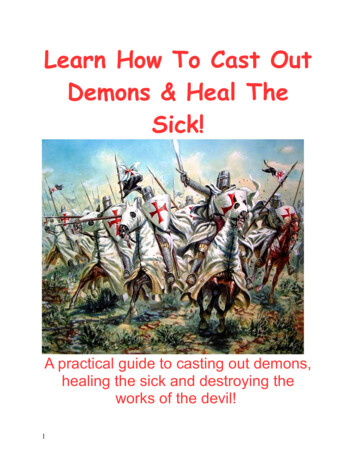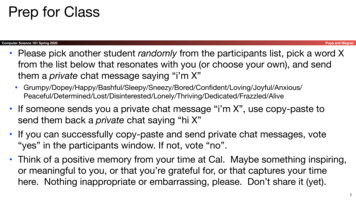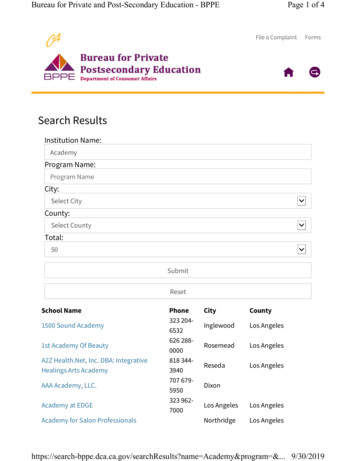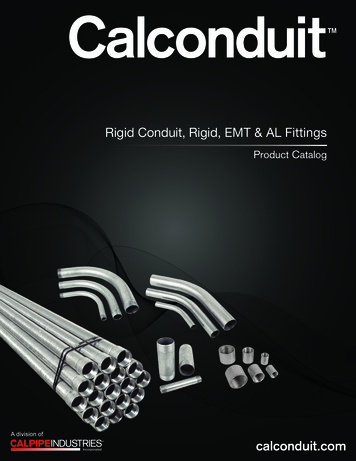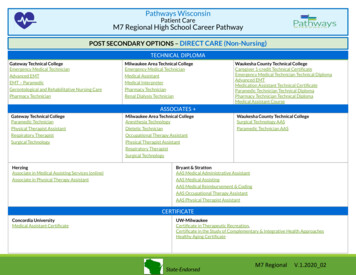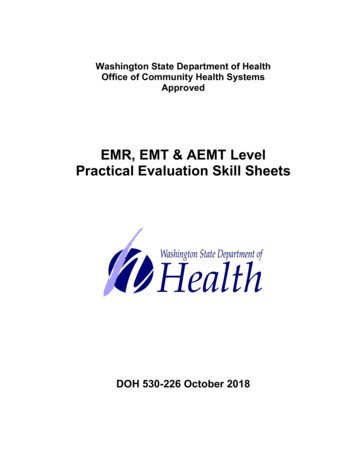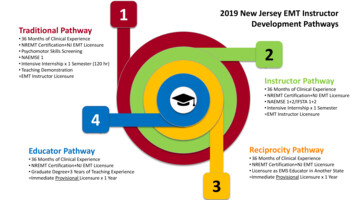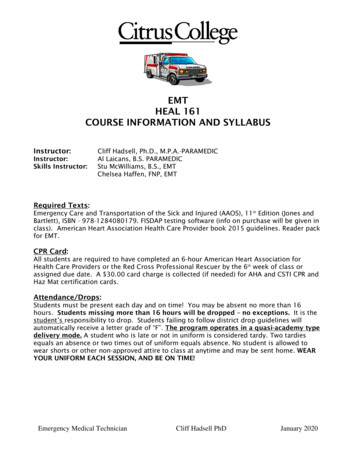
Transcription
EMTHEAL 161COURSE INFORMATION AND SYLLABUSInstructor:Instructor:Skills Instructor:Cliff Hadsell, Ph.D., M.P.A.-PARAMEDICAl Laicans, B.S. PARAMEDICStu McWilliams, B.S., EMTChelsea Haffen, FNP, EMTRequired Texts:Emergency Care and Transportation of the Sick and Injured (AAOS), 11th Edition (Jones andBartlett), ISBN - 978-1284080179. FISDAP testing software (info on purchase will be given inclass). American Heart Association Health Care Provider book 2015 guidelines. Reader packfor EMT.CPR Card:All students are required to have completed an 6-hour American Heart Association forHealth Care Providers or the Red Cross Professional Rescuer by the 6th week of class orassigned due date. A 30.00 card charge is collected (if needed) for AHA and CSTI CPR andHaz Mat certification cards.Attendance/Drops:Students must be present each day and on time! You may be absent no more than 16hours. Students missing more than 16 hours will be dropped – no exceptions. It is thestudent’s responsibility to drop. Students failing to follow district drop guidelines willautomatically receive a letter grade of “F”. The program operates in a quasi-academy typedelivery mode. A student who is late or not in uniform is considered tardy. Two tardiesequals an absence or two times out of uniform equals absence. No student is allowed towear shorts or other non-approved attire to class at anytime and may be sent home. WEARYOUR UNIFORM EACH SESSION, AND BE ON TIME!Emergency Medical TechnicianCliff Hadsell PhDJanuary 2020
EMT-BCOURSE INFORMATION AND SYLLABUSPage 2EMT Course Completion Certificates:In order to receive an EMT Course Completion Certificate from Citrus, you must haveobtained a score of 80% or above on your final examination, successfully pass all skillsexaminations and have a class overall percentage of 80% and pass a proctored online test atFISDAP with a score of 70% or better (on one of two attempts). In addition, you mustsuccessfully complete 20 hours of hospital clinical visits and 30 hours of ambulance ridealong or combination. Evaluations must be acceptable based on rubric and preceptornarrative criteria. Any student who is sent home or turned away for any reason, includingbeing late (other than hospital JC audits, internal disaster, or ride-along requirement changeby agency) and/or is evaluated by preceptor personnel to lack emotional maturity is deemedto have failed the evaluation process for successful completion. Students successful in allcategories of the program are eligible to sit for the National Registry EMT examination. Uponsuccessful completion of the NREMT you are then able to obtain your California State EMSAuthority EMT certification card/license.Final Grades:The final grade will be determined by a point system. The point system is based on theculmination of all quizzes taken, your mid-term, your final examination and your homeworkquizzes. Letter grades are assigned as follows: 100-90% A, 80-89% B, 70-79% C,60-69% D, below 60% F.Homework:Approximately 15 homework (practice tests) assignments will be given during this course.The homework assignment web location is FISDAP TESTING website listed under homeworkon our web page. Homework (practice tests) is for your benefit and does not count towardsyour overall grade, unless you fail to complete them. Assignments not submitted orreceiving less than 70% have 5 points removed from the student’s overall grade.Final Examination:The exam will consist of approximately 150 questions and will be similar to the quizzes andMid- Term. You will be allowed 1 minute per question (2.5 hours) to complete theexamination. You can only take this exam one-time.Emergency Medical TechnicianCliff Hadsell PhDJanuary 2020
EMT-BCOURSE INFORMATION AND SYLLABUSPage 3Other Important Information:There is a tremendous amount of information to be covered in a relatively short period oftime. The material is covered rapidly. You must stay organized. Tape recorders are highlyuseful in this class. It is imperative that you do all the required reading in order for youto be successful in passing the quizzes and ultimately the new National Registry EMTexamination. Study groups are also highly encouraged.On occasions, you will note minor discrepancies between what is said in class and what isstated in the book. When a discrepancy has occurred and a question comes up on a quiz,you need to go by what is stated in class and not what is stated in the book. Los Angelesoperates under certain protocols that differ than what is stated in your book. I will makeevery attempt to answer all your questions at the time they arise. Depending upon theextent of the questions asked I may need to defer answering it at the time until a break,before class or after class.Office Hours:These are scheduled approximately one-half hour before class and one-half hour after classor by appointment. My office hours will be posted on my office door (CFI 309). You areencouraged to contact me via email at Chadsell@citruscollege.edu. I try to respond within24 hours to all emails. I also have a mailbox in TB 206.Miscellaneous:The instructor reserves the right to modify/change the course as needed or as directed bythe Los Angeles County Department of Health Services. The classroom must be put back inorder prior to leaving. Students who have poor driving records or have criminal historyshould consult the instructor prior to beginning class. All students who have been convictedof certain felonies are automatically precluded from certification. All candidates must be 18years of age on or before the first day of class and have a HS diploma or GED. All CitrusCommunity College District policies are adhered to. Physical examinations, TB examinationsand verification of required immunizations must be submitted by the assigned due date 5thweek or 2nd week summer. Failure to do so results in immediate drop from class. NOEXCEPTIONS!!Grooming:All students must conform to ride-along grooming policies by the clinical sign ups. Men –no facial hair other than neatly trimmed mustache. Hair must be off the collar and ofnatural color. Women must wear hair up. Students must always exhibit excellent groomingstandards while in clinical/ride-along. No visible body piercing, etc. allowed. Tattoos mustalways be covered. No excessive jewelry allowed. Hands must be clean with no excessivedirt/grease, etc. Students must be in uniform each class period; no open toed footwearallowed (i.e. flip flops) only tennis shoes or uniform shoes allowed. Additionally, ride-alongand/or clinical sites may have additional grooming requirements.Emergency Medical TechnicianCliff Hadsell PhDJanuary 2020
EMT-BCOURSE INFORMATION AND SYLLABUSPage 4Disability:If you have a disability documented by a physician or other appropriate professional andwish to discuss academic accommodations, please contact the DSPS office at (626) 9148675. Please discuss your accommodation with me during office hours or after class. Pleaseallow at least one week to arrange appropriate classroom or testing accommodations.Students are expected to lift patients in a safe manner and be free from physicalrestrictions. Students are expected to lift (with assistance) 150 pounds and have free rangeof motion in all extremities. EMS students are part of the 911 response and are expected tofunction in the same physical/emotional capacity as the responders themselves.Additionally, students must be able to pass a random drug test if requested, No student canbe under “pain management program “or impaired by any substance whether prescribed bya licensed physician or other health care provider at anytime during the program of study.FERPA:Under the provisions of the Family Educational Rights and Privacy Act (FERPA) the progressof a student in a course at Citrus College can only be discussed with the student, unless thestudent agrees in writing to allow someone else to be apprised of their progress.Emotional Maturity:The training you receive demands emotional maturity. Students who do not exhibit thosequalities both in the classroom and clinical settings will be asked to leave or be dropped.This is a demanding field of study and not everyone is emotionally prepared to besuccessful. Because the college seeks to provide a reasonably safe environment forEmergency Medical Technician (EMT) students, faculty and for the clients entrusted to theircare, a student may be required during the program to demonstrate s/he physical and/oremotional fitness to meet the requirements of the course. Such essential requirements mayinclude the ability to perform certain physical tasks, and suitable emotional fitness. Thefaculty reserves the right to ask an EMT student to submit to psychological testing orcounseling if deemed necessary. The cost of this testing/counseling will be theresponsibility of the student. Any appraisal measure used to determine such medical/oremotional fitness will be in compliance with section 504 of the Rehabilitation Act of 1973and the Americans with Disabilities Act of 1990.Emergency Medical TechnicianCliff Hadsell PhDJanuary 2020
EMT-BCOURSE INFORMATION AND SYLLABUSPage 5Disruptive BehaviorDisruptive classroom behavior, including sleeping, eating, engaging in side conversations,studying for another class, or any other activity that interferes with learning, is unacceptableand the disruptive student will be asked to leave the classroom. An absence will then berecorded for the entire session. Classroom seating arrangements may be assigned, moved orchanged periodically to stimulate class interaction. Leaving the classroom is allowed only inan emergency. Leaving in the middle of the class for any reason is disruptive and notacceptable. Leaving before the end of the class will be considered an absence. All studentsare required to review the student code of conduct (BP 5500). This document can be foundon the Citrus main web page.EMS Prep 100:Concurrent enrollment or completion of EMS Prep 100 is required to complete EMT-BCheating/Plagiarism/Falsification of RecordsStudents who plagiarize, cheat or falsify records will be asked to leave and willreceive an “F” in the class. NO EXCEPTIONS!Cell PhonesCellular phones and similar devices are prohibited in the classroom, lab and clinicalride-along facilities. Students caught talking on cell phones or text messaging duringclass, clinical or ride along rotations may be immediately asked to leave by staff andwill be dropped from the program.Make up exam and finalOne make-up exam will be given due to absence only. Only one attempt is allowedfor the final examination. Students must achieve an 80% or better to pass, and mustpass the Fisdap at 70% on one of two attempts to be eligible to take the NREMTIndividual Malpractice InsuranceEach student is required to obtain individual mal practice insurance at the same time theyturn in their physical/TB test. The insurance may be obtained through www.hpso.com for avery nominal amount.Emergency Medical TechnicianCliff Hadsell PhDJanuary 2020
EMT-BCOURSE INFORMATION AND SYLLABUSPage 6Equipment:Students are required to have the following items by the second week of class: Stethoscope Approved Citrus EMT Uniform Polo ShirtB/P cuff (do not purchase one where the stethoscope and cuff are(attached, i.e. home model)Blue cotton twill form fitting pants (i.e. Dickie brand)Penlight2” three ring binder8-tab indexEMS scissors12 scantronsPencils/pensEmergency Medical TechnicianCliff Hadsell PhDJanuary 2020
Each EMT student must be able to communicate equivalent to the 9th grade 8th month levelwithout exception.OBJECTIVES, RATIONALES, AND STUDENT LEARNING OUTCOMESRelated to Communication SkillsOBJECTIVERATIONALESTUDENT LEARNINGOUTCOMESThe student will give a verbalstatement as directed. Thestatement will be clearlyunderstandable and will beconsistent with the directionsgiven by the instructor.A. The student willdemonstrate effectiveverbal communication inEnglish.Relates to the need for verbalexchange of information amongpeople in the clinical setting,such as shift-change reportand leadership of other teammembers.B. The student willdemonstrate effectivewritten communication inEnglish.Relates to the need for writtencommunication among healthcare providers in the clinicalsetting, such as documentation inpatient care reports (PCR) andcharts.The student will write a narrativereport from data supplied invarious forms including writteninput, verbal input, and visualobservations. The report will belegible, will have correct spellingand punctuation, and willdemonstrate the proper use ofgrammar.C. The student willdemonstrate the abilityto correctly interpretand act on verbalcommunication.Relates to the need for verbalexchange of information amongpeople in the clinical setting, andthe need to take actions basedon the information received.The student will correctly performone or more tasks as given in averbal directive.D. The student willdemonstrate the abilityto correctly interpretand act on writtencommunication.Relates to the need to interpretdata (e.g. MD orders, andPreceptor direction) in the clinicaland ride-along setting, and totake appropriate actions basedon the data.The student will correctly performone or more tasks as directed ina written statement.Emergency Medical TechnicianCliff Hadsell PhDJanuary 2020
EMT-BCOURSE INFORMATION AND SYLLABUSPage 7College Success TipsOrganization tipsAttend all classes.Arrive to class on time. Don’t be tardy.Stay for the entire class. Do not leave early unless permission is given.Read the textbook or other assigned material before coming to class.Come to class fully prepared to discuss the subject.Make a note of all assignments and homework in an assignment calendar.Take thorough notes during class. Review them regularly.Ask questions during class if you need clarification on anything.Review your notes immediately after class.Plan to spend approximately two hours outside of class in study time for each one hour ofclassroom time for the course.Study tipsSchedule regular study sessions. Plan sessions for when you are most awake and alert.Find a place to study that provides the type of environment that works best for you. Somestudents need a quiet place, while others need “background noise” to concentrate best.Join a study group with other members of your class.Study in short, frequent sessions.Take regular breaks.Read the textbook and highlight key concepts and vocabulary words.Make notes from the textbook.Combine these notes with notes from the classroom.Review these notes regularly.Use note cards or flashcards to help you learn the material.Recite the material out loud to reinforce your learning.If any item is unclear, write down your questions and bring them to class.Tips for taking testsReview your notes and flashcards immediately before class.Follow all test directions.Read each question slowly and completely for a clear understanding of the question.Changes to Syllabus or Course OutlineThe Instructor (s) reserve the right to make changes in the course outline, the coursesyllabus, or the instructors’ individual syllabi as neededEmergency Medical TechnicianCliff Hadsell PhDJanuary 2020
EMT-BCOURSE INFORMATION AND SYLLABUSPage 8Health Insurance Portability and Accountability (HIPPA)EMT students shall be bound by all applicable previsions of the HIPAA Act of 1996 and shall,upon request by clinical, college. and ambulance site administrators are required to signsuch declarations to maintain confidentiality of patient information obtained through allclinical activities as mandated by clinical sites utilized by the EMT program.Patient Rights and Respect for IndividualEvery person has a right to privacy in all aspects of life, and only that person can givepermission to waive that right. Health care professionals must respect the confidentiality ofall information which is procured in the process of treating the patient, includingpsychological, physiological, social, and institutional information, be shared only withpertinent staff, faculty, and fellow students. Names of patients may NEVER be revealed toother students, family, and friends.Social Media -HIPPAEMT students must be mindful that posting any information on or communication withinsocial media sites (Blogs, twitter, etc.) can be construed to be in violation of HIPPA rules andare subject to monitoring and/or subpoena by plaintiff attorneys and law enforcement.Citrus college student EMTs are prohibited from violating any and all HIPPA rules whichresult in immediate expulsion from the program and expose the EMT student personally, topotential criminal and civil liabilities.ELIGIBILITY FOR NREMT BOARD EXAMINATIONStudents are eligible and released to take the NREMT when they have met ALL the followingcriteria:1. Receive an 80% or higher on the in class final examination (one attempt only)2. An 80% course overall grade point average3. Pass with a 70% one of two proctored attempts Fisdap final exam software (twoattempts, you need only pass once) Please note: A student could pass the class and not pass Fisdap testingwhich precludes them from taking the NREMT board exam.Student Learning Outcomes1. Identify and explain the use of a 12 lead EKG2. Analyze and identify surface anatomy3. Express an understanding of the principles of emergency medical service legalregulations.4. A complete list of EMT student learning outcomes and objectives can be found at:http://curricunet.com/CITRUS/reports/course outline.cfm?courses id 1912Emergency Medical TechnicianCliff Hadsell PhDJanuary 2020
Emergency Medical Technician (EMT) students, faculty and for the clients entrusted to their care, a student may be required during the program to demonstrate s/he physical and/or emotional fitness to meet the re
